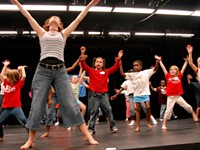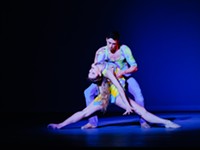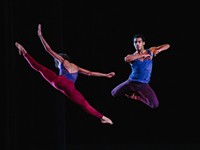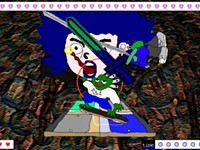[
{
"name": "500x250 Ad",
"insertPoint": "5",
"component": "15667920",
"parentWrapperClass": "",
"requiredCountToDisplay": "1"
}
]
Saturday was the final night of Fringe, the last show I went to, and, damn, am I glad I did. "Transient Being," choreographed by Eran David P. Hanlon in collaboration with performing artist AlainaOlivieri and visual artist Joseph Tarantelli moved me like nothing else I've seen at the festival. Olivieri's arresting movements reflected the deconstruction and rebirth theme of Tarantelli's projected video," FALL WINTER SPRING," a documentary that shows the making of the painting by the same name.
The studio space of Gallery r provided an intimate setting for this hard-hitting emotional piece. The audience (including many dancers) waited perched on wooden blocks clustered around a drop cloth of sorts that held big puddles of paint -- red, white and blue. The audience quieted as Tarantelli suspended an orange sponge above the stage set; next, he lifted up a bowl of yellow paint, soaking the sponge, which began dripping and coloring the large wooden block placed below it. Then, hushed silence except for the splot of the drips splashing down rapidly before dwindling to a hesitant drip...drop, drip...drop, drip....
Finally, Olivieri entered, completely transformed: face whitened, teeth blackened, hair twisted and matted with clay slip and mud, and body covered in white-gray paint with splotches of color and bands of red around her arms and waist. What immediate impact! She looked creepy. Otherworldly. I thought of Gollum from "The Hobbit." And zombies.And Hiroshima.
As she edged tentatively around the walls of the gallery, head and shoulders hunched, arms stiff at her sides, and eyes downcast, people turned their heads and then bodies to follow her progress, as one might at the sighting of a wild animal. She crept, she inched, she froze and the audience remained transfixed. Dance is not all about whirlwind movement, speed and height. It is also about slowness in moving through space and stillness in that space one occupies.
Olivieri circled the room until she reached the screen where Tarantelli's video was playing, showing pleasing, fast-flowing imagery capturing the process of painting. Rich colors were slapped onto canvas and brushed together in sped-up time. Olivieri drew back in alarm before cautiously beginning to engage with the images, extending an arm into a stream of colored light, then a leg, veering from frightened to exploratory. Then she turned away from the video and began interacting with the actual puddles of paint on the floor. Like a very young child in discovery mode, she darted a finger in and out of the paint as if it could be dangerous. Emboldened, she then smeared paint along her whole arm. Her breathing became audible here, as if she were becoming more alive, more human. For me, it seemed a metaphor for an awakening through art.
I found Hanlon's choreography most powerful during the midsection of the piece. On screen, the paint was being scraped away; we watched the hand wielding a flat-edged painting knife to scrub the canvas clean. White.Winter. The title of the video was not displayed until the end of the performance, however, so I did not make these seasonal connections until after the show was over. I would have liked to have had the fall, winter, spring theme in my mind as I watched.
Meanwhile, the rasp of the scraping suffused through the hush of the studio occupied by the observers. Olivieri's movements here mirrored both the actual and thematic content of the video. With her face contorted in anguish -- wide-mouthed grimaces, shifting jaw, and silent prolonged screams -- she began the process of stripping herself clean, just as winter lays bare the earth before the renewal of spring. I (indeed, all the audience) watched, mesmerized, as she began, in obvious agony, to literally peel layers of herself off, oh so slowly. I definitely felt the influence of butoh dance here. The slow, protracted movements.The display of humanity's dark and vulnerable side.
"One of the most difficult challenges in dance is stillness," Olivieri told me post-performance. "I wondered if people would still be engaged."
Believe me, they were.
Speaking of...
Latest in Culture
More by Casey Carlsen
-

A new generation
Jun 7, 2017 -

Dance review: RCB's 'Summer of Love'
Apr 21, 2017 -

Dance review: Garth Fagan home season
Dec 1, 2016 - More »





